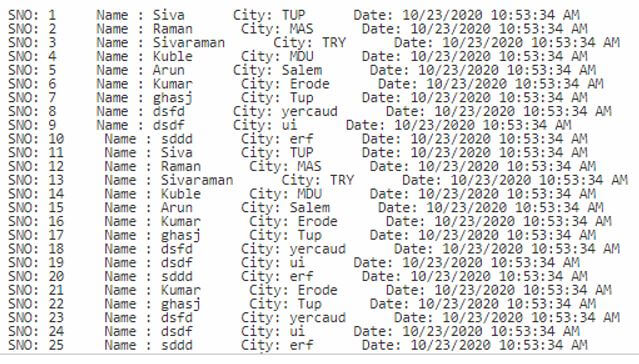Updated April 17, 2023

Introduction to C# DataTable
The C# DataTable is defined as the class which contains a number of rows and columns for to storing and retrieving the data’s from both the memory and the database; it also represents the grid forms in the UI areas; it’s a C# ADO.NET package class using that class we can add the datas to the datatable, and we will bind the datas in the same both datatable and datagridview controls using the data binding concepts. It also contains the primary key that depends upon the one or more number of columns in the table, and the data collections are only the uniqueness in the rows and columns values.
Syntax of C# DataTable
Normally the datatable class provides the set of methods and properties for CRUD operations and additionally like a copy, remove and clone operations. The datatable class have the methods like to add or remove the rows and columns in the table.
using system;
using System.Data;
class classname
{
returntype methodname()
{
DataTable referencename=new DataTable();
referencename.Columns.Add(); //Adding the columns to the table
referencename.Rows.Add(); // Adding the rows to the table
---some logics—
}
Main()
{
DataTable referencename=methodname();
---some logics based on the requirement---
}
}The above codes are the basic syntax for the datatable in the C# language. We can do the Add or Remove operation from both the rows and columns. It has some predefined methods in the datatable for storing and retrieving the datas in the database.
How DataTable works in C#?
- The datatable is the part of the System Classes like the System.Data in the table namespaces.
- Using these class, we can add, select and iterate the datas in the database. And also, the datatable class additionally used in the clone operations; with the help of filters, we can store and retrieve the datas in the table.
- It has its own constraints, and by using the primary key, we can do the operations in a unique nature.
- The constraints are that it’s one of the property that can allow users to access all the datas in the table, like parent and child relationship tables.
- We can also create the sub-tables by using the primary key and the parent table reference; the object is created separately in both the tables.
- We can also create our own customized views as well as the table contains the default view property. The datatables are displayed using the DataGridView Control in the user interface.
Examples of C# DataTable
Given below are the examples of C# DataTable:
Example #1
Code:
using System;
using System.Data;
public class Example
{
public static void Main()
{
DataTable dtable = new DataTable();
dtable.Columns.Add("SNO", typeof(int));
dtable.Columns.Add("Name", typeof(string));
dtable.Columns.Add("City", typeof(string));
dtable.Columns.Add("Date", typeof(DateTime));
dtable.Rows.Add(1, "Siva", "TUP", DateTime.Now);
dtable.Rows.Add(2, "Raman", "MAS", DateTime.Now);
dtable.Rows.Add(3, "Sivaraman", "TRY", DateTime.Now);
dtable.Rows.Add(4, "Kuble", "MDU", DateTime.Now);
dtable.Rows.Add(5, "Arun", "Salem", DateTime.Now);
dtable.Rows.Add(6, "Kumar", "Erode", DateTime.Now);
dtable.Rows.Add(7, "ghasj", "Tup", DateTime.Now);
dtable.Rows.Add(8, "dsfd", "yercaud", DateTime.Now);
dtable.Rows.Add(9, "dsdf", "ui", DateTime.Now);
dtable.Rows.Add(10, "sddd", "erf", DateTime.Now);
dtable.Rows.Add(1, "Siva", "TUP", DateTime.Now);
dtable.Rows.Add(2, "Raman", "MAS", DateTime.Now);
dtable.Rows.Add(3, "Sivaraman", "TRY", DateTime.Now);
dtable.Rows.Add(4, "Kuble", "MDU", DateTime.Now);
dtable.Rows.Add(5, "Arun", "Salem", DateTime.Now);
dtable.Rows.Add(6, "Kumar", "Erode", DateTime.Now);
dtable.Rows.Add(7, "ghasj", "Tup", DateTime.Now);
dtable.Rows.Add(8, "dsfd", "yercaud", DateTime.Now);
dtable.Rows.Add(9, "dsdf", "ui", DateTime.Now);
dtable.Rows.Add(10, "sddd", "erf", DateTime.Now);
dtable.Rows.Add(11, "Siva", "TUP", DateTime.Now);
dtable.Rows.Add(12, "Raman", "MAS", DateTime.Now);
dtable.Rows.Add(13, "Sivaraman", "TRY", DateTime.Now);
dtable.Rows.Add(14, "Kuble", "MDU", DateTime.Now);
dtable.Rows.Add(1, "Arun", "Salem", DateTime.Now);
dtable.Rows.Add(16, "Kumar", "Erode", DateTime.Now);
dtable.Rows.Add(17, "ghasj", "Tup", DateTime.Now);
dtable.Rows.Add(18, "dsfd", "yercaud", DateTime.Now);
dtable.Rows.Add(19, "dsdf", "ui", DateTime.Now);
dtable.Rows.Add(20, "sddd", "erf", DateTime.Now);
dtable.Rows.Add(21, "Kumar", "Erode", DateTime.Now);
dtable.Rows.Add(22, "ghasj", "Tup", DateTime.Now);
dtable.Rows.Add(23, "dsfd", "yercaud", DateTime.Now);
dtable.Rows.Add(24, "dsdf", "ui", DateTime.Now);
dtable.Rows.Add(25, "sddd", "erf", DateTime.Now);
dtable.Rows.Add(26, "Kumar", "Erode", DateTime.Now);
dtable.Rows.Add(27, "ghasj", "Tup", DateTime.Now);
dtable.Rows.Add(28, "dsfd", "yercaud", DateTime.Now);
dtable.Rows.Add(29, "dsdf", "ui", DateTime.Now);
dtable.Rows.Add(30, "sddd", "erf", DateTime.Now);
dtable.Rows.Add(20, "sddd", "erf", DateTime.Now);
dtable.Rows.Add(31, "Kumar", "Erode", DateTime.Now);
dtable.Rows.Add(32, "ghasj", "Tup", DateTime.Now);
dtable.Rows.Add(33, "dsfd", "yercaud", DateTime.Now);
dtable.Rows.Add(34, "dsdf", "ui", DateTime.Now);
dtable.Rows.Add(35, "sddd", "erf", DateTime.Now);
dtable.Rows.Add(36, "Kumar", "Erode", DateTime.Now);
dtable.Rows.Add(37, "ghasj", "Tup", DateTime.Now);
dtable.Rows.Add(38, "dsfd", "yercaud", DateTime.Now);
dtable.Rows.Add(39, "dsdf", "ui", DateTime.Now);
dtable.Rows.Add(40, "sddd", "erf", DateTime.Now);
dtable.Rows.Add(41, "sddd", "erf", DateTime.Now);
dtable.Rows.Add(42, "Kumar", "Erode", DateTime.Now);
dtable.Rows.Add(43, "ghasj", "Tup", DateTime.Now);
dtable.Rows.Add(44, "dsfd", "yercaud", DateTime.Now);
dtable.Rows.Add(45, "dsdf", "ui", DateTime.Now);
dtable.Rows.Add(46, "sddd", "erf", DateTime.Now);
dtable.Rows.Add(47, "Kumar", "Erode", DateTime.Now);
dtable.Rows.Add(48, "ghasj", "Tup", DateTime.Now);
dtable.Rows.Add(49, "dsfd", "yercaud", DateTime.Now);
dtable.Rows.Add(50, "dsdf", "ui", DateTime.Now);
dtable.Rows.Add(51, "sddd", "erf", DateTime.Now);
int n=0;
DataRow[] row;
row = dtable.Select("City='Tup'");
n = row.Length;
Console.WriteLine(“Welcome Users”);
Console.WriteLine(n);
}
}Output:
Example #2
Code:
using System;
using System.Data;
public class Example
{
public static void Main()
{
DataTable dtable = new DataTable();
dtable.Columns.Add("SNO", typeof(int));
dtable.Columns.Add("Name", typeof(string));
dtable.Columns.Add("City", typeof(string));
dtable.Columns.Add("Date", typeof(DateTime));
dtable.Rows.Add(1, "Siva", "TUP", DateTime.Now);
dtable.Rows.Add(2, "Raman", "MAS", DateTime.Now);
dtable.Rows.Add(3, "Sivaraman", "TRY", DateTime.Now);
dtable.Rows.Add(4, "Kuble", "MDU", DateTime.Now);
dtable.Rows.Add(5, "Arun", "Salem", DateTime.Now);
dtable.Rows.Add(6, "Kumar", "Erode", DateTime.Now);
dtable.Rows.Add(7, "ghasj", "Tup", DateTime.Now);
dtable.Rows.Add(8, "dsfd", "yercaud", DateTime.Now);
dtable.Rows.Add(9, "dsdf", "ui", DateTime.Now);
dtable.Rows.Add(10, "sddd", "erf", DateTime.Now);
dtable.Rows.Add(11, "Siva", "TUP", DateTime.Now);
dtable.Rows.Add(12, "Raman", "MAS", DateTime.Now);
dtable.Rows.Add(13, "Sivaraman", "TRY", DateTime.Now);
dtable.Rows.Add(14, "Kuble", "MDU", DateTime.Now);
dtable.Rows.Add(15, "Arun", "Salem", DateTime.Now);
dtable.Rows.Add(16, "Kumar", "Erode", DateTime.Now);
dtable.Rows.Add(17, "ghasj", "Tup", DateTime.Now);
dtable.Rows.Add(18, "dsfd", "yercaud", DateTime.Now);
dtable.Rows.Add(19, "dsdf", "ui", DateTime.Now);
dtable.Rows.Add(20, "sddd", "erf", DateTime.Now);
dtable.Rows.Add(21, "Kumar", "Erode", DateTime.Now);
dtable.Rows.Add(22, "ghasj", "Tup", DateTime.Now);
dtable.Rows.Add(23, "dsfd", "yercaud", DateTime.Now);
dtable.Rows.Add(24, "dsdf", "ui", DateTime.Now);
dtable.Rows.Add(25, "sddd", "erf", DateTime.Now);
dtable.Rows.Add(26, "Kumar", "Erode", DateTime.Now);
dtable.Rows.Add(27, "ghasj", "Tup", DateTime.Now);
dtable.Rows.Add(28, "dsfd", "yercaud", DateTime.Now);
dtable.Rows.Add(29, "dsdf", "ui", DateTime.Now);
dtable.Rows.Add(30, "sddd", "erf", DateTime.Now);
foreach (DataRow r in dtable.Rows)
{
Console.WriteLine("SNO: {0}\t Name : {1} \t City: {2} \t Date: {3} \t ", r[0], r[1], r[2], r[3]);
}
}
}Output:
Example #3
Code:
using System;
using System.Data;
public class Example
{
public static DataTable demo()
{
DataTable dtable = new DataTable();
dtable.Columns.Add("SNO", typeof(int));
dtable.Columns.Add("Name", typeof(string));
dtable.Columns.Add("City", typeof(string));
dtable.Columns.Add("Date", typeof(DateTime));
dtable.Rows.Add(1, "Siva", "TUP", DateTime.Now);
dtable.Rows.Add(2, "Raman", "MAS", DateTime.Now);
dtable.Rows.Add(3, "Sivaraman", "TRY", DateTime.Now);
dtable.Rows.Add(4, "Kuble", "MDU", DateTime.Now);
dtable.Rows.Add(5, "Arun", "Salem", DateTime.Now);
dtable.Rows.Add(6, "Kumar", "Erode", DateTime.Now);
dtable.Rows.Add(7, "ghasj", "Tup", DateTime.Now);
dtable.Rows.Add(8, "dsfd", "yercaud", DateTime.Now);
dtable.Rows.Add(9, "dsdf", "ui", DateTime.Now);
dtable.Rows.Add(10, "sddd", "erf", DateTime.Now);
return dtable;
}
public static void Main()
{
DataTable tables = demo();
foreach (DataRow r in tables.Select())
{
if (r["SNO"].ToString().Equals("2"))
{
tables.Rows.Remove(r);
}
}
Console.WriteLine("Welcome After removing the datas");
foreach (DataRow r1 in tables.Rows)
{
Console.WriteLine("SNO: {0}\t Name : {1} \t City: {2} \t Date: {3} \t ", r1[0], r1[1], r1[2], r1[3]);
}
}
}Output:
Conclusion
The datatable class is also used for the other predefined classes and the objects of the tables, and mainly this is coordinated and tied with each other. And also, the application wises the datas to be populated directly from the database. Using the datagrid view, the datas are shown on the user screen.
Recommended Articles
This is a guide to C# DataTable. Here we discuss the introduction, how DataTable works in C#? along with examples respectively. You may also have a look at the following articles to learn more –



